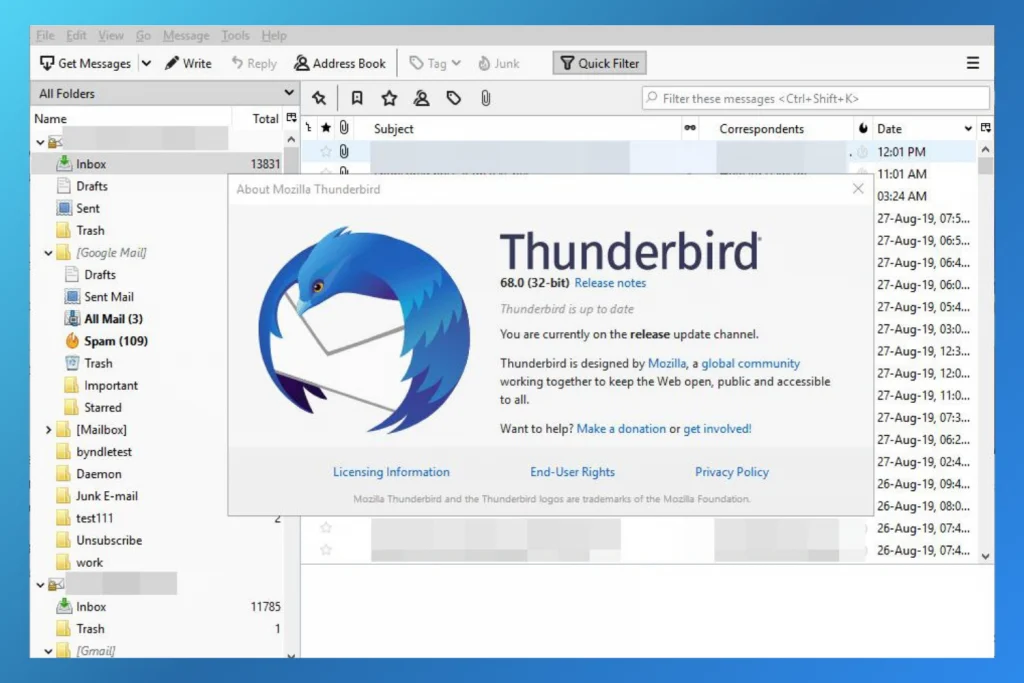Short answer:Apple Mail is the native, simple client with tight macOS/iOS integration. Thunderbird is a powerful, cross-platform client with add-ons and deep customization. Pick based on search reliability, multi-account control, send-safety (undo/send-delay), and privacy.
If you’re reading this article, you’re likely trying to decide whether to choose Apple Mail or Thunderbird as your primary email client. You may already be using one of these two email providers and wondering whether switching to the other is the right move for you.
While Apple Mail is the most popular email client among Apple device users, some may find it insufficient for their needs, mainly due to its lack of versatility and customization. For those looking for an Apple Mail alternative that allows for more customization and compatibility with different operating systems, Thunderbird can be a great option.
In this article, we make a quick yet detailed comparison between these two email clients to help you make an informed decision.
[cta-block:ctablock3, title="Still choosing between Apple Mail and Thunderbird?", subtitle="Pick the workflow that fits: safer sending, better search, multiple accounts.", button1="Try it Free", button1link="https://canarymail.io/downloads", button2="Compare Apple Mail alternatives", button2link="https://canarymail.io/blog/apple-mail-alternatives"]
Apple Mail vs. Thunderbird: Quick Comparison
Instead of going through a lengthy comparison, let’s get straight to the point. Which is better, Thunderbird or Apple Mail? Which one should you choose?
For starters, you have to know that Apple Mail and Thunderbird are two fundamentally different email clients. Apple Mail is Apple’s default email client, pre-installed and available for free on every Apple device, while Thunderbird is an open-source email client developed by Mozilla. While Apple Mail is tightly integrated with the Apple ecosystem, Thunderbird is available for multiple operating systems, such as Windows, macOS, and Linux.
Here are the main differences between Apple Mail and Thunderbird in various categories.
🛠️ Apple Mail vs. Thunderbird: Features

Introduced by Apple as part of its macOS and iOS operating systems, Apple Mail has been a favorite among Apple device users. Apple Mail integrates seamlessly across all Apple devices and apps. If you’re using the Apple ecosystem, from iCloud to Calendars and Notes on various macOS and iOS devices, Apple Mail is a great choice.
Thunderbird, on the other hand, is a free, open-source email client by Mozilla that offers cross-platform compatibility and extensive customization options, including the ability to install various add-ons and extensions to tailor the email experience to your preferences.
What’s more, Thunderbird’s open-source nature means that it’s constantly evolving with community contributions and updates, so its feature suite is expanding and changing.
Here are Apple Mail’s main features:
Here are some of Thunderbird’s main features for a quick comparison:
Overall, if you prioritize flexibility, customization, and compatibility across multiple operating systems and devices, Thunderbird may be the better choice for you.
🏆 Verdict: Thunderbird takes the crown in terms of features.
👤 Apple Mail vs. Thunderbird: User Experience
Apple Mail offers a sleek, modern design that can sometimes sacrifice the user experience for the sake of aesthetics. It also provides a unified inbox for users with multiple accounts, which is excellent for email organization, although it falls short in terms of interface customization options.
[cta-block:ctablock2, title="Too many inboxes to manage?", button1="Download Now", button1link="https://canarymail.io/downloads", button2="Manage multiple accounts", button2link="https://canarymail.io/blog/best-email-app-multiple-accounts"]
On the other hand, Thunderbird’s interface is outdated, which can be an issue for users looking for a modern and sleek interface. However, Thunderbird compensates for its outdated design with extensive customization options via a range of plugins and add-ons you can install to tailor it to your preferences.

The main difference between Apple Mail and Thunderbird is that Apple Mail works only on Apple devices. In contrast, Thunderbird works with multiple operating systems, such as Windows, macOS, and Linux.
Although Thunderbird cannot be accessed via the web browser and cannot be used on mobile devices, it’s still more versatile than Apple Mail, which can only be used on Apple devices.
🏆 Verdict: Thunderbird takes the crown in terms of user experience thanks to its customization options and versatility.
🧠 Apple Mail vs. Thunderbird: AI Capabilities
At the time of writing this article, neither of the two email clients offers ChatGPT-powered email writing capabilities or a specialized AI-driven email assistant.
In terms of AI capabilities, Apple Mail integrates with Siri, which allows users to use voice commands for actions like email dictation and searches within the mailbox. It also offers Smart Search, which is an AI-driven search functionality that predicts user needs and speeds up the email search process.
Thunderbird, on the other hand, is an open-source platform that relies heavily on community contributions. As of now, its AI capabilities are relatively limited, focusing primarily on basic email functions like spam filtering.
🏆 Verdict: Apple Mail takes the crown in terms of AI capabilities thanks to its voice search capabilities.
🔓 Apple Mail vs. Thunderbird: Privacy
Both Apple Mail and Thunderbird offer strong email privacy and security features but in slightly different ways.
For instance, Apple Mail offers standard security features like end-to-end encryption and spam and phishing protection. What’s more, it allows users to hide their email so they can send and receive emails without sharing their real address.
On the other hand, Thunderbird, being an open-source platform, is more transparent about its security protocols. In addition to end-to-end encryption, it also allows users to manage encryption methods and key settings, giving them more control over their privacy.
🏆 Verdict: Thunderbird takes the crown in terms of email privacy.
💰 Apple Mail vs. Thunderbird: Pricing
Both Thunderbird and Apple Mail are free to use. You can download Apple Mail to use on your Mac or iPhone. On the other hand, Thunderbird is available for download on multiple platforms, including Windows, macOS, and Linux, at no cost.
There are no subscription fees or hidden costs associated with either email client. However, with Apple Mail, you can subscribe to the iCloud service, which offers additional features such as expanded storage, enhanced security, and seamless integration with other Apple services, like iCloud Drive.
🏆 Verdict: It’s a tie. Both Thunderbird and Apple Mail are free to use.
Apple Mail vs. Thunderbird: Comparison Summary
FeaturesApple MailThunderbirdUser ExperienceOffers a sleek, modern design that can sometimes sacrifice the user experience for the sake of aestheticsThunderbird’s interface is outdated, it compensates for its outdated design with extensive customization optionsAINo AI email assistantNo AI email assistantPrivacySecurity features like end-to-end encryption, as well as spam and phishing protectionIn addition to end-to-end encryption, it also allows users to manage encryption methods and key settings, giving them more control over their privacy.PricingFreeFree
Thunderbird vs. Apple Mail: The Final Verdict
In summary, both Apple Mail and Thunderbird offer similar email management features and a comparable user interface (Thunderbird’s is more outdated than Apple Mail’s).
Apple Mail will be a better choice if you’re deeply embedded in the Apple ecosystem and want an email client that seamlessly syncs across all your devices. However, if you’re looking for a highly customizable, open-source, and cross-platform email client, Thunderbird will be a better option.
Ultimately, the choice between Apple Mail and Thunderbird boils down to individual needs and preferences.
Comparison table
Thunderbird vs. Apple Mail: The FAQs
Which is better, Apple Mail or Thunderbird?
Both have strengths. Apple Mail offers native macOS/iOS integration and a simple UI. Thunderbird is cross-platform with powerful add-ons and customization. If you need more than the basics, compare options in Apple Mail alternatives or see tools for multiple accounts. You can also start a trial on the Download page: /download.
Can Apple Mail import Thunderbird?
Yes—by using MBOX exports. In Thunderbird, export mailboxes as MBOX and import them into Apple Mail. After import, check folder mapping and rules. If you’re switching clients entirely, review Apple Mail alternatives.
Does Thunderbird work with iOS?
There’s no official Thunderbird app for iOS. You can still access the same accounts on iPhone with compatible clients via IMAP/POP. If you manage many inboxes on mobile, see best email app for multiple accounts.
Does Thunderbird email work on a Mac?
Yes. Thunderbird runs on macOS (as well as Windows/Linux). If you want a native-feel client or different workflows on Mac, compare Apple Mail alternatives.
Can I use either app with iCloud, Gmail, or Microsoft 365?
Yes. Both Apple Mail and Thunderbird connect to iCloud, Gmail, Microsoft 365, and standard IMAP/SMTP. If you’re choosing based on workflow, start with Apple Mail alternatives.
Which is better for privacy and encryption?
Thunderbird supports OpenPGP natively and S/MIME; Apple Mail supports S/MIME and can use OpenPGP via plug-ins. For engagement measurement, avoid relying on “opens.” Learn why in read receipts on Mac and track engagement without opens.
How do I avoid sending mistakes?
Enable a send-delay / undo-send window (10–30s) and use scheduled send for timing. See practical tips in can you really unsend an email on iPhone?.
Are read receipts reliable?
Not universally—many providers block them and privacy features obscure opens. Use link-clicks and short reply prompts for reliable signals. Details: read receipts on Mac and email read receipts guide.
What if I manage many inboxes?
Pick a client built for multiple accounts with unified inbox, per-account rules, and strong search. Start here: best email app for multiple accounts. If you’re ready to try a new client, go to /download.
How do I migrate between Apple Mail and Thunderbird?
Export mailboxes as MBOX from the source app, then import into the destination. Recreate rules/filters and verify signatures, identities, and folders after import. For alternatives during migration, see Apple Mail alternatives.
[cta-block:ctablock1, title="One inbox for all accounts. Get started today", button="Install free", buttonlink="https://canarymail.io/downloads"]